Top Composite Pickleball Paddles in 2025
With an understanding of the integral features to consider, it’s time to explore some of the top-rated composite pickleball paddles recommended for players in 2025. These selections consider performance across various dimensions such as control, power, and overall value.
Best Overall: Selkirk Vanguard
The Selkirk Vanguard series stands out as the best overall option in 2025, offering a balance of design, performance, and user-friendliness. The Vanguard's Quantum-CarbonFiber face is engineered to provide excellent durability along with enhanced power transfer during play. Its Flexfoam perimeter technology serves to absorb impacts, aiding in precision and control. This paddle excels in maneuverability, making it suitable for players aiming for quick shots and opportunities.
Moreover, the average user rating of 4.4 out of 5 stars speaks to its popularity and effectiveness across different skill levels, ranging from beginners to advanced competitors. Players also appreciate the aesthetic designs of the Vanguard series, providing attractive options for both casual and competitive settings.
Best for Control: Franklin Signature Pro
For players prioritizing control, the Franklin Signature Pro paddle is a top contender. This paddle's composite construction features a textured surface that enhances grip and feel, making precise shot placement easier. Weighing between 7.4 to 7.7 ounces, it strikes an ideal balance between maneuverability and stability, offering an elongated shape that increases the sweet spot further.
The paddle also caters to various grip size options, ensuring a comfortable fit for players with different hand sizes. In high-pressure situations, this paddle shines, allowing users to focus on strategy and accuracy.
Best for Power: Paddletek Bantam EX-L
The Paddletek Bantam EX-L is recognized as one of the best paddles for power in 2025. Leveraging the advanced Bantam PolyCore technology, this medium-weight paddle weighs between 7.8 to 8.4 ounces, providing both explosive power and fine control. Its high-grade polycarbonate surface allows players to generate impressive ball spin, improving shot velocity and overall effectiveness.
With a large sweet spot, the Bantam EX-L caters to aggressive players looking to dominate the court with powerful shots while minimizing discomfort during extended play thanks to its ergonomic grip design.
Best for Spin: Vatic Pro Prism Flash
Recognized for its exceptional spin capabilities, the Vatic Pro Prism Flash is tailored for high-performance play in 2025. Featuring a surface built from raw TORAY T700 carbon fiber, it enhances durability while facilitating effective spin control. This paddle design incorporates unibody foam walls, contributing to a sweet spot that benefits overall control during play, creating significant advantages in spin generation.
Most notably, the PRISM Flash is positioned as a budget-friendly option under $100, delivering competitive performance that rivals higher-priced alternatives. This feature makes it especially appealing for both beginners and advanced players striving for enhanced spin without requiring a hefty investment.
Best Set: Garye Pickleball Paddles Set of 4
The Garye Pickleball Paddles Set of 4 offers tremendous value for families or groups interested in engaging with pickleball together. This set includes lightweight yet robust paddles, allowing for a balance of power and spin across varied play styles.
Comprising four paddles, this set caters excellently to both recreational and competitive play. The versatility of having multiple paddles ensures players can enjoy the game without the need to invest in individual paddles, significantly reducing long-term costs.
Best Budget: Tenvina Hercules Pickleball Paddles
For players on a budget, Tenvina Hercules paddles present an excellent blend of affordability and performance. These paddles are designed with a focus on providing durability and stability without exceeding financial limits. Their lightweight design enhances maneuverability, which is essential for quick reaction during matches.
The large sweet spot featured in these paddles makes them ideal for beginners, aiding in developing skills without overwhelming costs. They're typically priced between $50 to $80, making high-functioning paddles accessible to everyone, ensuring that players can enjoy the game without significant financial strain.
Best for Beginners: Mten MT-01 Pickleball Paddles
The Mten MT-01 paddles are especially designed for beginners. Constructed with a lightweight composite core, these paddles provide excellent shock absorption, critical for reducing arm fatigue during extended gameplay. With a large sweet spot, beginners can make consistent contact with the ball, facilitating smoother swings and a more enjoyable experience on the court.
Pricing for the Mten MT-01 stays deliberately affordable, allowing newcomers to invest wisely without overwhelming expenditures as they learn and improve their skills.
Understanding Composite Pickleball Paddles
Composite pickleball paddles are defined by their construction, which generally involves a blend of materials designed to enhance performance. The term “composite” refers to the combination of various elements, primarily fiberglass, carbon fiber, and polymers, resulting in paddles that offer a balance of power, control, and spin. This section will delve into the unique characteristics that distinguish composite paddles from their wooden and graphite counterparts, setting the stage for a comprehensive exploration of their benefits.
Benefits of Playing with a Composite Paddle
When it comes to composite pickleball paddles, players can reap numerous benefits that elevate their gaming experience. Here are the key advantages:
-
Enhanced Power: Composite paddles often deliver more power than wooden alternatives due to their construction and materials. This makes them ideal for aggressive players seeking to dominate the court.
-
Exceptional Ball Control: The textured surfaces often found in composite paddles allow for better ball control. Players can make precise shots and execute various techniques, enhancing their overall performance.
-
Superior Spin Capabilities: With their textured surfaces, composite paddles enable increased ball spin. This is particularly advantageous when aiming for strategic plays that require effective spin application.
-
Increased Durability: Compared to wooden paddles, composite variants hold up better over time, reducing the frequency of replacements and ensuring longer-lasting performance.
-
Versatility: These paddles cater to various playing styles, from beginners to advanced professionals. Their design accommodates both power-focused and control-oriented play.
-
Quieter Play: Many composite paddles employ materials like polymer honeycomb cores, which reduce noise during gameplay. This is particularly beneficial in community settings where noise regulations may be in place.
Composite paddles come with various configurations, all tailored to meet specific player preferences and requirements.
Common Composite Materials Used in Pickleball Paddles
Understanding the materials used in composite paddles is vital for selecting the right one for your play style.
-
Fiberglass: Known for its affordability and durability, fiberglass provides a balanced blend of power and control. It has excellent spin capabilities due to its textured surface, though it tends to weigh more than other composite materials.
-
Carbon Fiber: This material boasts a high strength-to-weight ratio, making it lighter while offering enhanced power and control. Although sometimes lacking the spin potential of fiberglass, carbon fiber paddles excel in providing a responsive touch.
-
Polymer Honeycomb Cores: Typically made from polypropylene, these cores are popular due to their shock absorption properties, offering a softer feel and reducing vibrations. This leads to a more comfortable playing experience.
-
Aluminum Cores: Less common than polymer options, aluminum cores provide unique performance attributes, including added weight and stability. They can optimize power for players who prefer heavier paddles.
By knowing these materials, players can better understand paddle performance characteristics and select their ideal composite paddle accordingly.
Key Factors to Consider When Choosing a Composite Pickleball Paddle
As we explore the various elements crucial to paddle selection, it’s essential to note that the "best" composite paddle varies based on individual needs and playing style. Key factors include:
Weight
Paddle Weight and Gameplay: The weight of a pickleball paddle significantly affects your style of play. Here’s what you need to know:
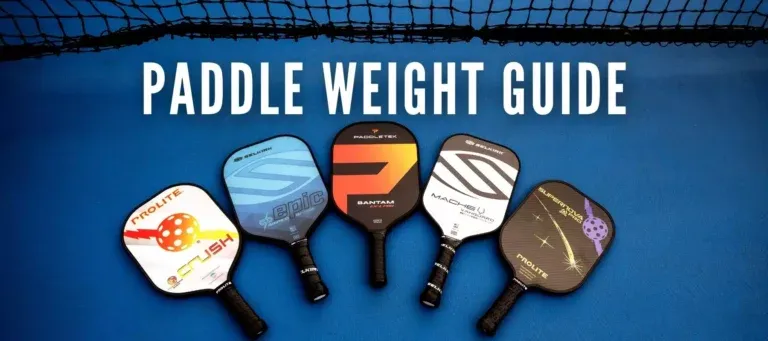
-
Weight Categories:
- Lightweight: Under 7.5 ounces, ideal for quick swings and agility.
- Mid-weight: 7.5 to 8.4 ounces, providing a balanced combination of power and control.
- Heavyweight: 8.5 ounces and over, typically offering more stability and power.
-
Impact on Maneuverability and Control: Lighter paddles facilitate faster reactions and are easy to maneuver, making them great for dinks and net play. Conversely, heavier paddles assist in delivering more powerful groundstrokes, making them suitable for players who prefer aggressive play.
-
Consideration for Skill Levels: Beginners may favor lighter paddles to build confidence, whereas advanced players might opt for mid to heavy paddles for control in competitive situations.
Paddle Face Material
The paddle face material significantly influences gameplay and spin potential:
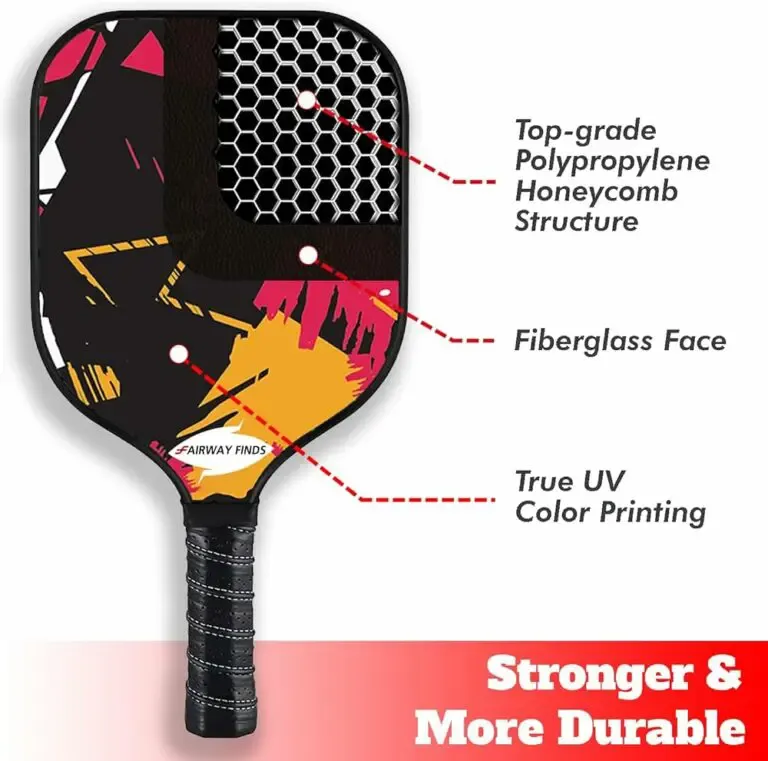
- Fiberglass vs. Carbon Fiber: Fiberglass is often chosen for recreational play due to its balance of durability and power. Carbon fiber offers superior responsiveness and control, making it more suitable for competitive players looking to finesse their shots.
- Surface Textures: Different face textures can contribute to spin generation. Paddles with textured surfaces allow for more significant grip on the ball, enhancing spin capabilities.
- Innovative Technologies: Brands incorporate technologies like MaxGrit and Carbon Friction surfaces to optimize spin potential, giving players an edge in gameplay.
Core Material and Thickness
The core material used in composite paddles plays a crucial role in how they perform on the court:
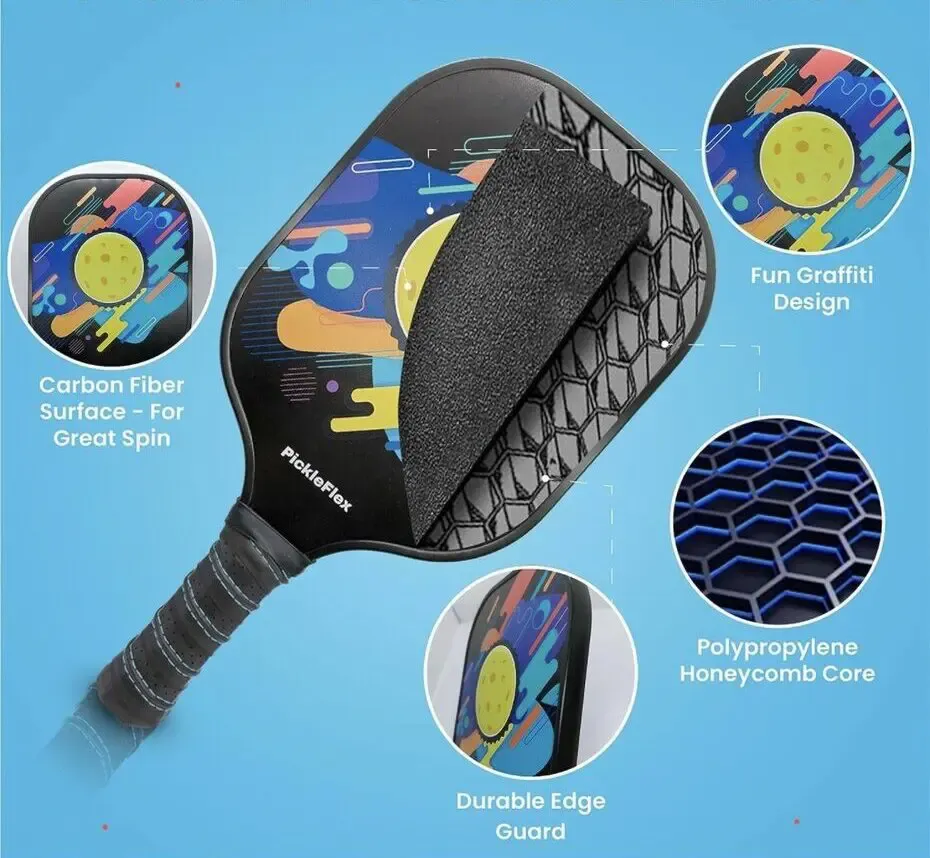
- Polymer Honeycomb: Known for shock absorption and a softer feel, polymer cores improve comfort and are often preferred for their balanced performance and durability.
- Nomex Cores: Offering a firmer feel, Nomex is excellent for players seeking maximum power. However, these cores tend to produce more noise, which could be a downside in quieter settings.
- Core Thickness: Thicker cores typically provide a larger sweet spot and enhanced control, which is beneficial for players needing more precision. On the other hand, thinner cores may offer quicker reaction times, allowing for swift maneuvers.
Grip Size and Length
Choosing the right grip size and length is essential for comfort and performance:
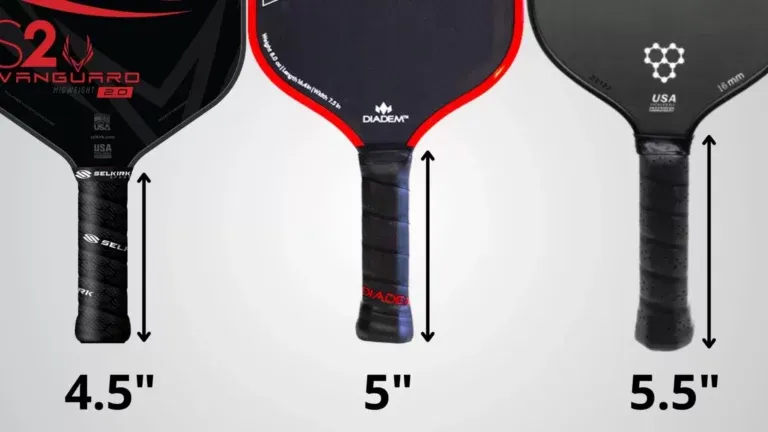
- Grip Circumference: Standard sizes often range from 4 ¼ to 4 ½ inches in diameter. An improper grip size can lead to strain during extended play, affecting control.
- Grip Length: Typical grip lengths are around 5 inches. A longer grip may assist players using two-handed backhands, ensuring better handling in various scenarios.
- Comfort Features: Paddles with grips designed for comfort, such as Selkirk’s Geo Grip or Gamma Honeycomb Grip, can significantly enhance feel and reduce fatigue.
Paddle Shape and Size
The paddle's shape profoundly affects its sweet spot and overall playability:
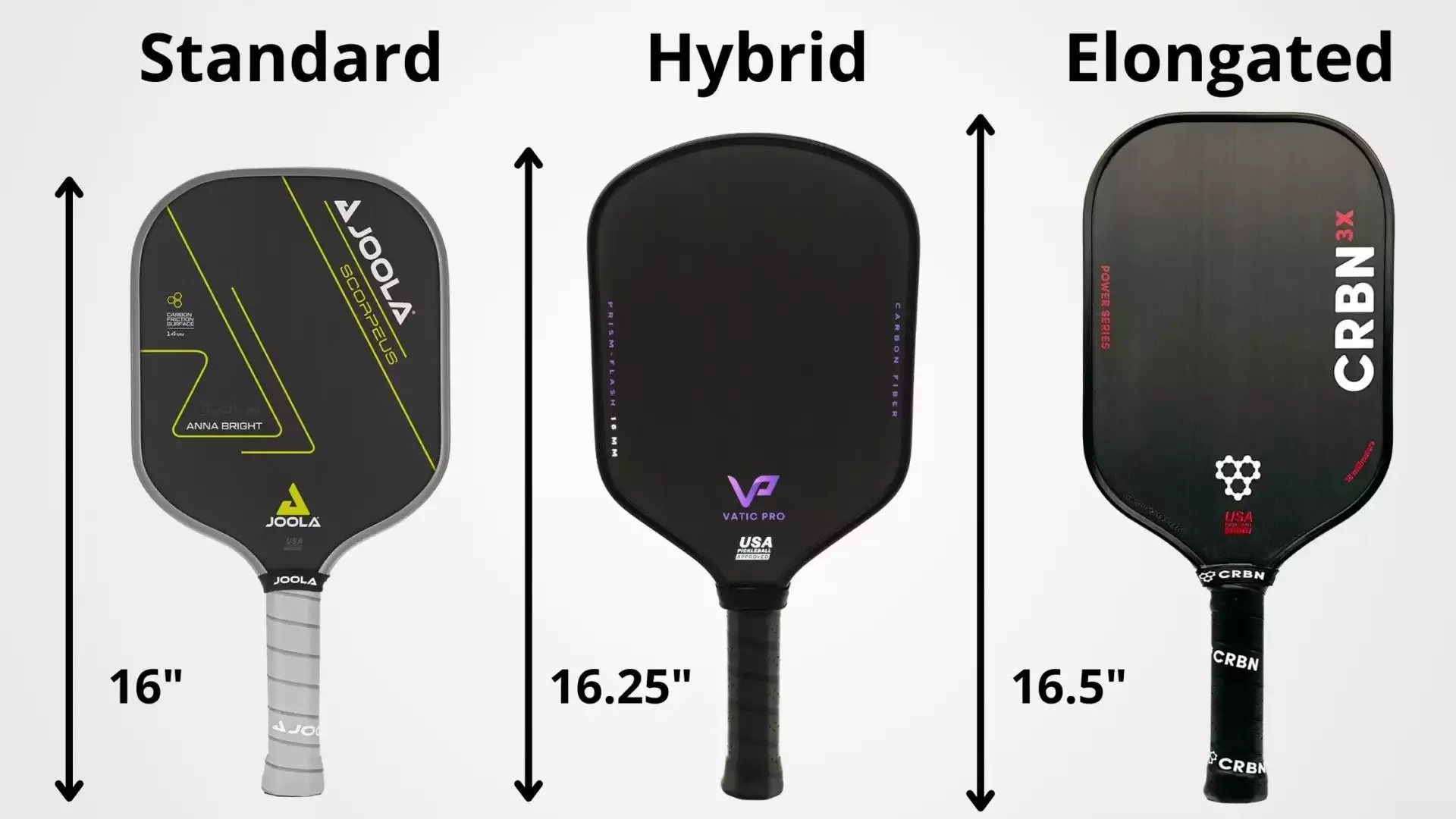
- Standard Dimensions: Most paddles fall between 15 to 16 inches in length and 7 to 8.25 inches in width. These dimensions provide a balance of reach and control.
- Elongated Paddles: These offer greater reach, which can be beneficial for players who prioritize power in their groundstrokes.
- Wider Paddles: Wider paddles provide increased sweet spots, making it easier for players to hit shots consistently.
- Edgeless Designs: Paddles with edgeless designs offer a larger sweet spot and diminish mishits, enhancing overall performance.
Price
Choosing a right pickleball paddle that fits your budget while maintaining quality and performance is essential:
-
Price Ranges: Composite paddles can vary significantly in price, generally ranging between $50 to $250. Factors like brand reputation, materials, and technology contribute to price variations.
-
Value for Money: Assessing the long-term benefits of a paddle is crucial. While opting for budget-friendly options is wise, investing in a more premium paddle may provide better performance and durability in the long run.
Choosing the Right Composite Paddle for Your Play Style
Selecting the right composite paddle to match your personal play style is crucial for both enjoyment and development on the court. This ensures that players maximize the benefits that different paddle features offer to enhance their performance.
For Beginners
New players should focus on lightweight paddles that enhance control and improve responsiveness. It’s advisable to choose paddles with larger sweet spots for more forgiving play mechanics. Composite materials that absorb shock, such as polymer honeycomb, provide comfort during use.
Additionally, beginners might want to explore more affordable options to ensure they feel comfortable committing without breaking the bank.
For Intermediate Players
Intermediate players often look for a balance of power and control. It’s beneficial to choose paddles that excel in spin potential, adapting their games with added finesse. Players transitioning from sports like tennis might consider paddles that cater to their established skills.
Medium-weight paddles with advanced materials, such as carbon fiber, support performance while still being forgiving when learning new techniques.
For Advanced Players
Advanced players typically seek paddles that allow for maximum spin, power, and precision in their games. Heavier paddles often provide the stability necessary for executing complex techniques during fast-paced matches.
Customizability with grip lengths and sizes matters here, along with the technologies built into the paddle, ensuring performance aligns closely with the player’s preferences. Prioritizing advanced materials, like those present in top-tier paddles, will help achieve the desired results in competitive scenarios.
Caring for Your Composite Pickleball Paddle
Caring for your composite pickleball paddle ensures longevity and optimal performance over time. Knowing how to maintain it properly will enhance your playing experience on the court.
Cleaning
Regular cleaning is essential for paddle maintenance. After each use, gently wipe down the paddle with a damp, lint-free cloth to prevent dirt and debris build-up. For deeper cleaning, use a soft cloth soaked in a mix of mild soap and warm water. Avoid harsh chemicals, which may damage the materials.
Cleaning the grip regularly is vital. Remove sweat and grime to keep it tacky and comfortable. If needed, a specialized paddle cleaner can be used to maintain the surface effectively.
Storage
Proper storage is critical to maintaining paddle integrity. Avoid exposing your paddle to extreme temperatures, as heat and cold can warp materials. Instead, store your paddle in a cool, dry place.
Using a protective case is advisable. When not in use, consider vertical storage to reduce pressure on the paddle's face and edges, which can help maintain its shape and usability.
Final Thoughts
In conclusion, the right composite pickleball paddle can significantly influence your playing experience, whether you're a beginner just starting or a seasoned player looking to refine your technique. Factors like weight, grip size, core material, and price all contribute to your choice, but it ultimately comes down to personal preferences and style of play.
Composite paddles offer a unique blend of power, control, and durability, making them an excellent choice for players back to all levels. Ultimately, investing time into research and possibly testing various paddles can lead to a more enjoyable and enhanced pickleball experience on the court.
FAQs
Are composite paddles heavier than graphite paddles?
Typically, composite paddles are heavier due to the material composition. While graphite paddles range from 6 to 9 ounces, composite paddles usually weigh between 7 to 10 ounces. This weight difference can affect maneuverability and power during play.
Is fiberglass the only material used in composite paddles?
No, fiberglass is one of the most common materials used in composite paddles; however, they often incorporate other materials like carbon fiber and polymers. The combination of these materials plays a significant role in defining the paddle's attributes and performance.
What are the main advantages of composite paddles for intermediate players?
For intermediate players, composite paddles offer a balanced mix of power and control, making them more forgiving in terms of shot accuracy. These materials provide significant feedback and allow for better performance while transitioning to advanced techniques.
How does the spin potential of a textured composite paddle compare to a smooth carbon fiber paddle?
Textured composite paddles generally provide superior spin potential compared to smooth carbon fiber paddles. The texture allows for better grip on the ball, enabling players to generate varied spins effectively, which is crucial for tactical play.
























